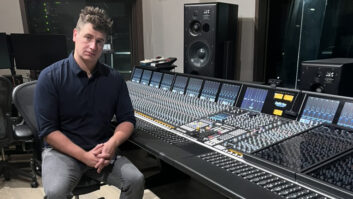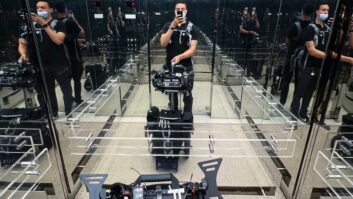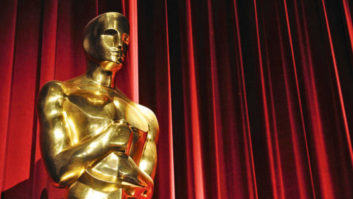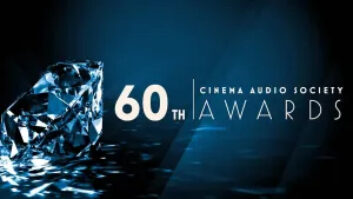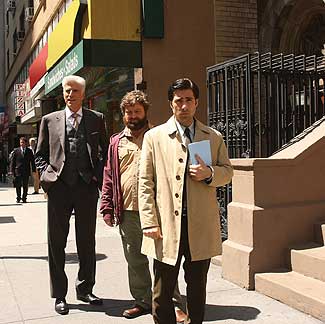
Ted Danson (left), Zach Galifianakis and Jason Schwartzman star in Bored to Death.
Bored to Death is a new HBO comedy series about an aspiring writer in Brooklyn who, as a lark and as a way to meet women after the breakup of a relationship, puts an ad on Craigslist claiming to be an unlicensed private detective. This leads this fan of Raymond Chandler and other noir writers to become involved in actual cases he probably has no business tackling. The series (which had its debut on September 20) is the brainchild of Brooklyn-based writer Jonathan Ames, and in the series Ames is played by the witty and versatile Jason Schwartzman. Ted Danson (Cheers, Becker) and Zach Galifianakis (The Hangover) co-star in this ensemble series, which Danson describes as “sweet, innocent and perverted.” The show was shot almost entirely on location in Brooklyn, and posted at Soundtrack Film & Television in Manhattan — it’s New York through and through.
Handling the challenging production sound for seven of the initial eight-episode run of the series was Griffin Richardson, an Emmy winner last year for his work on 30 Rock, which has been his main gig the past four years, and “the best job I’ve ever had in my life.” Griffin joined the Bored to Death team last spring after the pilot had been shot and 30 Rock shut down for the season. (Mathew Price, production mixer for The Sopranos and many other shows, did the pilot.) “Jonathan Ames, who’s the main creative force behind the show, used to write a column in a newspaper here in New York and he’s really funny,” Richardson says. “Then, once I heard the cast, it sounded way too good to pass up.
“They warned me on the phone: ‘Look, just so you know, we’re going to be on location 90 percent of the time.’ A lot of times in a movie or TV show, they’ll say the scene takes place here, but you really shoot somewhere else where it’s more convenient. But Jonathan was really insistent that we shoot at these specific locations. He really wanted to get the feel of this Brooklyn that he knew and loved and that he’d written about.”
A native of Duxbury, Mass., Richardson moved to New York originally to attend NYU film school: “I play music, and thought taking a sound class would be fun — and it was! There weren’t a whole lot of people in film school doing sound, so it was kind of easy to get experience quickly. Then, once someone finds out you know what you’re doing, a friend of a friend recommends you and…It happened kind of effortlessly, though obviously it’s a lot of effort because low-budget shoots are really hard.” He started as a boom operator but quickly moved into production sound mixing, plying his trade mostly on indie features and then episodic television. He also worked on the hilarious Web series Wainy Days (wainydays .com; check it out!), starring comedian David Wain. These days, he has a crew of two helping him out — boom operator Chris Fondulas has been with him for eight years; his utility/second boom, Bryant Musgrove, for about five.
Like nearly all current production mixers, Richardson uses a combination of boom mics and RFs worn by key cast members to get a full and accurate picture of each scene, and to provide plenty of options for the post mixer(s). “I prefer the boom mic whenever I can get away with it because it sounds fuller, more real and you have more of a sense of the physical place within the scene,” he comments. “But the radio mics these days work great and they can save your ass. They tend to flatten everything a little bit.” When he can, he’ll double-boom and sometimes also keep off-camera characters wired “because I’ve learned that in comedy, more often than not, it seems like when people are off-camera, they tend to relax and say a lot of funny stuff. When you have people like Jason and Ted Danson and Zach Galifianakis who are so good at improvising, you want to make sure you never miss anything.”

The production sound crew of Bored to Death (L-R): Griffin Richardson, Bryant Musgrove and Chris Fondulas
Photo: Matthew Clark
Richardson’s sound cart, “which has a lot of mileage on it,” is centered around a Fostex DV824 — “an 8-track that records simultaneously to a DVD-RAM and to a hard drive, so that’s good for backup. If somebody drops the DVD-RAM, or stomps on it accidentally, or maybe there’s a corrupted file on there somewhere, you’re okay. I’m a little excessively paranoid about backing everything up. Digital is such a great thing in so many ways, but files can get easily corrupted. I also have a Sound Devices 788T [as backup], which is fantastic. It’s incredibly compact and portable — I can easily go over the shoulder with it. For 30 Rock, we had to shoot a scene in the middle of the Brooklyn Bridge and we weren’t allowed to bring any carts — it was whatever you could carry. The 788 is like the size of a hardcover book, so it was just perfect for that.”
The mixer in Richardson’s cart is an Audio Developments AD 149. “It’s a great-sounding machine — expensive, but really solid; it can handle being out in crappy weather and dust and being bounced around in trucks.” As for the boom mics, for interiors he and his team rely mostly on the blue Schoeps CMIT 5U shotgun and some Sennheiser MKH 60; exteriors will usually be handled by a Neumann KMR 81 shotgun. He runs the booms wireless using Lectrosonics transmitters.
Not surprisingly, some locations for the series are more conducive to gathering clean audio than others; alas, the production mixer rarely gets a vote. “You know going in that there are going to be places that are really difficult,” Richardson offers. “If it’s a place that looks great and everyone wants to shoot there, you have to figure out a way to make it work, sound-wise.
“A couple of times I had to beg them, ‘Please go in and loop this scene!’ [Laughs] There was a shot right next to the Williamsburg Bridge with this subway passing through, which they really wanted to see because it’s a very striking image. That’s fine, but you’re going to hear it, too. In a case like that, if it sounds a little rough, it’s okay because at least it’s got the visual to go with it. They wanted it to look and sound real, and it does. We were shooting in tiny little bars, under bridges, over at Brighton Beach, all over the city.”
Then there was the skateboard chase in one episode: “Jason Schwartzman is trying to recover a stolen skateboard, and this gang of kids chases him down a hill on their skateboards. They had a Steadicam rig mounted to an off-road kind of [vehicle], and we originally thought of going over-the-shoulder for that, but instead we put the boom op on there wireless, and the range was good enough we got almost all the audio — this great sound of one skateboard coming down the hill and then eight or 10 coming behind it. It sounded so cool.”
At each locale, in addition to shooting all of the dialog scenes, Richardson would also capture upward of a minute of room tone or ambience “to capture the general sound of each space so they can loop it and layer it in [in post], maybe use it to cover any edits they need to make.”
As he worked each day, Richardson would “put a rough mix on track 1 of my machine, and then have every mic on its own track, 2 through 8, and I’d send that rough mix through a Cat-5 Ethernet cable to the HD video decks that are on set [being viewed by the likes of Jonathan Ames, producers from HBO, the writers of that particular episode and others]. Then, since they have that mix on the tape, they can start cutting the picture with that. Once it goes over to post, I turn in my DVD-RAM that has all of my tracks for every single take, identifying who’s on what track, what mics were used and what takes were good and bad as far as I was concerned. Then they have to sift through that mountain of stuff and make something usable out of it.” (At Soundtrack, the post team included mixer Bob Chefalas; editors Louis Bertini, Dave Ellinwood, Nick Renbeck and Dan Ward; ADR and Foley recordist Doug Murray; and Foley artist Leslie Bloom.)
It’s too early to tell whether this series will have life after its first eight-show run, but count Richardson among those who would love to be part of it again if it does survive. “All the people involved with this series were amazing to work with — funny, creative. It was also pretty stressful at times. There were days when we were shooting all night and it was raining. But then you get that one good take and it makes all the headaches worth it.”

